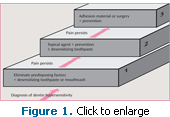
Tips for Chairside Hypersensitivity Treatment
Dental hygienists can help prevent tooth sensitivity before it starts with these strategies.
Dentin hypersensitivity affects more than 40 million people in the United States.1 Dental hygienists serve as the first line of defense in the prevention and treatment of this condition. Patients may initially address dentin hypersensitivity with their dental hygienist because sensitive areas may be stimulated by instrumentation. As such, patients’ medical and dental histories should be updated at each appointment, along with noting any habits that may be contributing to the onset and persistence of symptoms. This opportunity to connect and work with patients as partners in therapy is not only cost-effective but also can result in long-term relief of this common condition.
The most well known and accepted explanation behind dentin hypersensitivity is the hydrodynamic theory, which Brännström presented in 1963.2 Brännström showed that fluid movement in dentinal tubules caused by varying stimuli (tactile, chemical, evaporative, thermal, or pressure) displaces the nerve endings in the pulp. As a result, the nerve membranes depolarize, which elicits a pain response. The dentin tubules must be open at the tooth’s surface in order for hypersensitivity to occur.2 Treatments for hypersensitivity either occlude the dentinal tubules or block the nerve response.
Dentin hypersensitivity is caused by many factors including an acid-containing diet (erosion), gingival recession/periodontal diseases, abrasion, abfraction, attrition caused by bruxism, and microfractures. These all contribute to the loss of enamel and subsequent dentin exposure.3 Chairside treatment of dentin hypersensitivity has also evolved significantly in recent years with many new products available. Necessary characteristics of sensitivity treatment include efficient delivery, efficacy of mechanism, relief of clinical symptoms, and patient safety.
FLUORIDE VARNISH
Fluoride varnish is one of the most common chairside treatments in the fight against dentin hypersensitivity. Cunha-Cruz et al found that fluoride was the most frequently used chairside treatment (94% of 209 study participants), and it was the only method used by more than 50% of respondents.4 Applied chairside, fluoride varnish creates a barrier to adverse stimuli by occluding tubules through concentrated calcium fluoride on the tooth surface. This solidifies and blocks the open dentin tubules, reducing permeability and hypersensitivity.5
TABLE 1. QUESTIONS TO ASK PATIENTS ABOUT THEIR TOOTH SENSITIVITY.
- How long does the pain last?
- Is the pain dull or sharp?
- What triggers the onset of the pain?
- Are you in the process of whitening your teeth?
Fluoride varnish is easily applied, and although thorough drying of all tooth surfaces is recommended, varnish can set in the presence of saliva.6 Fluoride varnish’s disposable unit-dose application provides for simple chairside treatment. Fluoride varnish products have also benefited from advances in flavor and color, which have increased patient acceptance.
Patients should be instructed to leave the varnish on the teeth for several hours uninterrupted. Toothbrushing should be avoided immediately after application and hot liquids should not be consumed for several hours postapplication.
CALCIUM PHOSPHATE TECHNOLOGIES
Calcium phosphate technologies, including amorphous calcium phosphate (ACP), casein phosphopeptide-amorphous calcium phosphate (Recaldent®), calcium sodium phosphosilicate (NovaMin®), arginine and calcium carbonate (Pro-Argin™ technology), and tricalcium phosphate (TCP), are relatively new agents used to treat dentinal hypersensitivity as well as increase remineralization. Varying levels of research are available to support the efficacy of these technologies.
ACP releases calcium and phosphate ions in the presence of saliva to help the remineralization process. It occludes the dentinal tubules and provides an inventory of calcium and phosphate ions in saliva.7 For chairside treatment, ACP is available in Relief® ACP Oral Care Gel by Discus Dental. The gel can be brushed on or applied with a custom tray. Patients can also use the gel at home for continued sensitivity relief. ACP is available in two professionally dispensed take-home whitening products: NiteWhite® ACP and DayWhite® ACP by Discus Dental, and an over-the-counter treatment designed to increase tooth whitening and strengthen enamel, ARM & HAMMER® Whitening Booster plus Enamel Strengthening by Church & Dwight Co Inc.
Recaldent was introduced to the consumer market in 2002 in a chewing gum (Trident XtraCare™, Cadbury Adams). It was added to a tooth cream in 2004 (MI Paste™, GC America Inc). Recaldent’s complex of casein phosphopeptide, a protein found in milk, and ACP adheres to plaque on the tooth surface and releases calcium and phosphorous during an average acid challenge in the mouth, which can then be useful for tooth remineralization.8,9 Through this remineralization process, there may be a decrease in dentin hypersensitivity.10,11
Like fluoride varnish, MI Paste is simple to administer chairside. It can also be easily integrated into the patient’s daily oral hygiene routine. The paste is applied via cotton swab or finger dab in affected areas and left undisturbed for 3 minutes. MI Paste is also available with fluoride (MI Paste Plus™). Both pastes are available through prescription for patients to use at home. Recaldent is contraindicated for those with a milk protein allergy (casein IgE), so a thorough medical history must be taken and reviewed prior to recommending the use of this product.
NovaMin uses calcium, sodium, and phosphosilicate, elements naturally found in the body, particularly in saliva. When combined with saliva, these elements release in the form of ions and are quickly available for the remineralization of the tooth surface. NovaMin particles attach to the tooth surface and continue to release ions and remineralize after the initial application. These particles release ions and transform into a hydroxycarbonate apatite on the tooth surface for up to 2 weeks.12 The dentinal tubules are occluded by the hydroxyapatite layer and the remaining NovaMin particles.
 For chairside treatment, NUPRO Sensodyne Prophylaxis Paste with NovaMin is available from DENTSPLY Professional/GlaxoSmithKline. It is designed to occlude tubules and relieve sensitivity during an average prophy. A prescription toothpaste, Sensodyne NUPRO Professional Toothpaste with NovaMin (DENTSPLY Professional/ GlaxoSmithKline), as well as over-the-counter dentifrices (GlaxoSmithKline’s Sensodyne Repair & Protect, Dr. Collins Restore Remineralizing Toothpaste, and Burt’s Bees Natural Toothpaste) are available with NovaMin.
For chairside treatment, NUPRO Sensodyne Prophylaxis Paste with NovaMin is available from DENTSPLY Professional/GlaxoSmithKline. It is designed to occlude tubules and relieve sensitivity during an average prophy. A prescription toothpaste, Sensodyne NUPRO Professional Toothpaste with NovaMin (DENTSPLY Professional/ GlaxoSmithKline), as well as over-the-counter dentifrices (GlaxoSmithKline’s Sensodyne Repair & Protect, Dr. Collins Restore Remineralizing Toothpaste, and Burt’s Bees Natural Toothpaste) are available with NovaMin.
The combination of arginine, an amino acid found in saliva, and calcium carbonate comprises the new Pro-Argin™ technology. Arginine binds to the tooth surface and allows the calcium carbonate to slowly dissolve and release calcium that is readily available to remineralize the tooth surface. This method uses the natural attributes of saliva through the remineralization of tooth structure by consistently delivering calcium and phosphate into dentin tubules.13 Pro-Argin technology is used in Colgate® Sensitive Pro-Relief™ desensitizing paste, which is applied chairside with a rotary cup and prophy angle either before or after dental procedures to prevent hypersensitivity.
Research shows that arginine bicarbonate is effective in providing instant sensitivity relief when burnished onto sensitive teeth following professional dental prophylaxis, and that sensitivity relief can last for at least 28 days following a single in-office treatment.13 The study noted a 71.7% reduction in sensitivity when measured by air blast, and an 84.2% reduction when measured by a scratch test immediately following product application.13
TCP is a new material that is created by combining beta tricalcium phosphate and sodium lauryl sulfate.14 The combination is designed to make fluoride, phosphate, and calcium ions available to the teeth, which may aid in sensitivity reduction.15 TCP creates a protective barrier around the calcium so it coexists with the fluoride, then when the calcium contacts saliva the protective bubble breaks down so the calcium, phosphate, and fluoride ions are accessible to the tooth surface.16 It is available for chairside treatment in Vanish 5% Sodium Fluoride White Varnish with Tri-Calcium Phosphate and for at-home use in the prescription Clinpro 5000 1.1% Sodium Fluoride Anti-Cavity toothpaste.
PATIENT MANAGEMENT
Dentin hypersensitivity can only be properly diagnosed with a thorough medical history and assessment of habits and lifestyle through the process of differential diagnosis (process of elimination used to diagnose disease). When trying to manage patients with dentin hypersensitivity of any severity, a baseline measure of sensitivity should be determined by the use of a descriptive pain scale (is the pain mild, moderate, or severe) or visual analog scale (on a scale from 1-100 how bad is the pain with 100 being the most painful).17 Also, asking patients to demonstrate their oral hygiene practices is helpful because certain behaviors, such as aggressive toothbrushing, may contribute to symptoms. Table 1 lists additional questions to ask patients about their hypersensitivity symptoms. This form of self-evaluation will provide dental hygienists with invaluable insight and enable the development of a treatment plan best suited to the individual patient. The modality of treatment is largely contingent on the severity of pain as depicted by the pain ladder in Figure 1.18 The pain ladder demonstrates that less severity may equal more conservative treatments, such as behavior modification and a sensitivity toothpaste. If discomfort persists, more aggressive treatments may be needed.17,18
The vast array of options for chairside therapy of dentin hypersensitivity illustrates what an exciting time this is for dental hygiene. Now, more so than ever, we have the ability to greatly improve the quality of life for our patients.
REFERENCES
- Irwin CR, McCusker P. Prevalence of dentine hypersensitivity and plaque in a general dental population. J Ir Dent Assoc. 1997;43:7-9.
- Brännström M. A hydrodynamic mechanism in the transmission of pain producing stimuli through the dentine. In: Anderson DJ, ed. Sensory Mechanisms in Dentine. Oxford, England: Pergamon Press; 1963:73-79.
- Pashley DH, Tay FR, Haywood VB, Collins MA, Drisko CL. Consensus-based recommendations for the diagnosis and management of dentin hypersensitivity. Inside Dentistry. 2008;4(Suppl):1-35.
- Cunha-Cruz J, Wataha JC, Zhou L, et al. Treating dentin hypersensitivity: therapeutic choices made by dentists of the Northwest PRECEDENT Network. J Am Dent Assoc. 2010;141:1097-1105.
- Ritter AV, de L Dias W, Miguez P, Caplan DJ, Swift EJ Jr. Treating cervical dentin hypersensitivity with fluoride varnish: A randomized clinical study. J Am Dent Assoc. 2006;137:1013-1020.
- Abrams S. Treating hypersensitive dentin with fluoride varnish. Oral Health. 1999;89(5):43.
- Geiger S, Matalon S, Blasbalg J, Tung M, Eichmiller FC. The clinical effect of amorphous calcium phosphate (ACP) on root surface hypersensitivity. Oper Dent. 2003;28:496-500.
- Reynolds EC. Remineralization of enamel subsurface lesions by casein phosphopeptide— stabilized calcium phosphate solutions. J Dent Res. 1997;76:1587-1595.
- Shen P, Cai F, Nowicki A, Vincent J, Reynolds EC. Remineralization of enamel subsurface lesions by sugar-free chewing gum containing casein phosphopeptide-amorphous calcium phosphate. J Dent Res. 2001;80:2066-2070.
- Brännström M, Astrom A. The hydrodynamics of the dentine; its possible relationship to dentinal pain. Int Dent J. 1972;22:219-227.
- Orchardson R, Gillam DG. The efficacy of potassium salts as agents for treating dentin hypersensitivity. J Orofac Pain. 2000;14:9-19.
- Jennings DT, McKenzie KM, Greenspan DC, Clark AE. Quantitative analysis of tubule occlusion using NovaMin (calcium sodium phosphosilicate). J Dent Res. 2004;83:2416.
- Panagakos F, Schiff T, Guignon A. Dentin hypersensitivity: effective treatment with an inoffice desensitizing paste containing 8% arginine and calcium carbonate. Am J Dent. 2009;22:3A-7A.
- Hurlbutt M. Caries management with calcium phosphate. Dimensions of Dental Hygiene. 2010;8(10):40-46.
- Karlinsey RL, Mackey AC. Solid-state preparation and dental application of an organically modified calcium phosphate. J Mater Sci. 2009;44:346-349.
- Karlinsey RL, Mackey AC, Walker ER, Frederick KE. Surfactant-modified ß-TCP: structure, properties, and in vitro remineralization of subsurface enamel lesions. J Mater Sci. 2010;21:2009-2020.
- Orchardson R, Gillam DG. Managing dentin hypersensitivity. J Am Dent Assoc. 2006;137:990-998.
- Cancer pain relief and palliative care: report of a WHO Expert Committee. World Health Organ Tech Rep Ser. 1990;804:1-75.
From Dimensions of Dental Hygiene. April 2011; 9(4): 56, 58-59.

